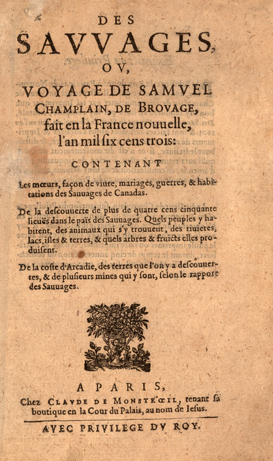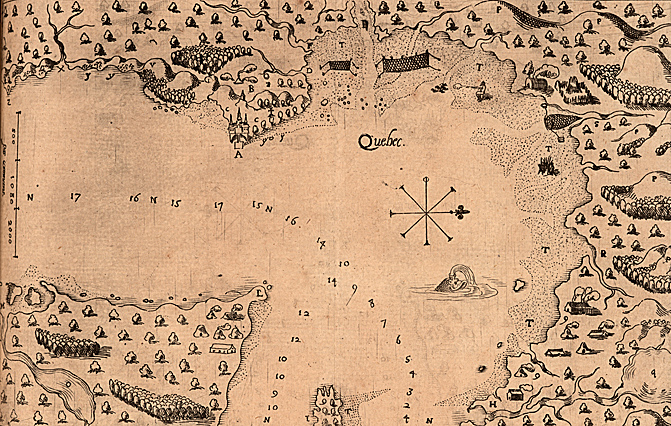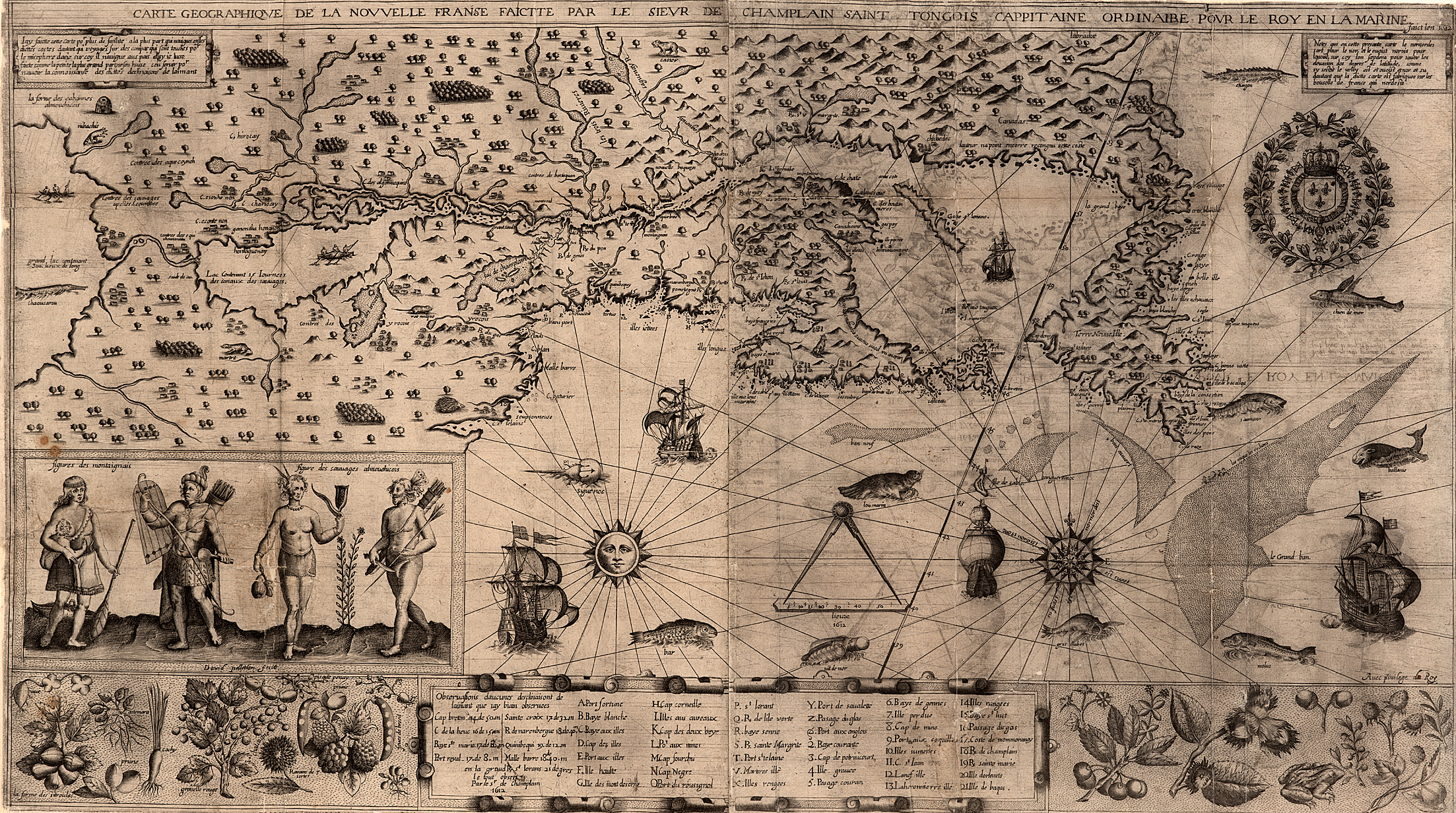Samuel de Champlain was born in Brouage, France. His date of birth is unknown, but estimated to be around 1570. For exploring North America in the name of France, Champlain was coined as the “Father of New France,” as he established the city of Quebec in Canada (then referred to as New France). As a child Champlain was well educated in cartography and mathematics. His father was a sea captain and taught him navigation from a young age with the inclusion of astronomy.His background also included the titles of soldier and diplomat. In 1603 Champlain embarked to North America in the name of Henry IV, King of France. This account of his first voyage to Canada was written and published in this year with the purpose of exploring the St. Lawrence River in Canada. Alan Taylor, author of American Colonies: The Settling of North America, address the motives behind Frances’ interest in Northern Expansion. Spain had already dominated most of the Caribbean and the southern lands of America. They were powerful and would not hesitate to destroy any competitors of unrelated colonies. Although, at the time, North America was viewed as a safer location for settlement, the French were hesitant because thus far there had been no findings of precious metals nor the very desired “North Passage.” This passage would have given any country the power to monopolize trade with Asia through a channel reaching across to the Pacific Ocean. However, if a passage was not located, the promise of any other fortune from the northern lands was so doubtful that the Emperor of Spain, who could have commissioned a blockade against French exploration of the St. Lawrence River, had said, ” As regards to settling in the Northern Sea, there is nothing to envy in this; for it is of no value, and if the French take it, necessity will compel them to abandon it” (Taylor 92). As the emperor had anticipated, the first French expedition let by Jacques Cartier failed to colonize due to the deathly cold, scurvy, and hostility from the natives. Taylor prefaces the reader that the hostility was “provokes by French thefts and threats” (92). Fortunately for France, the grim experiences shadowing northern expansion did not altogether halt business. A century after the first voyage, the French still managed to maintain a temporary livelihood through the profitable trade of fur and fish. Fish were seasonal but the fur trade of North America was especially valued because over-hunting in Europe had literally killed its own resources for this market.
One of the most interesting points Taylor makes concerns the issue of dependency. Historians have debated the weight of both the Indians and Europeans dependency upon the other. Taylor divulges in the mutuality of the business relationship claiming that the Indians and European powers had, in a sense, advanced the needs and wants of each party, changing their cultures. The Indians began to rely on the Europeans for metals, cloth, and alcohol. The Europeans were then succumbed to the Indian demands of trade and their own countries capitalistic demands.
 To make Indian-European relations easier, the Europeans realized they had to make alliances with tribes. However, by swearing allegiance to one tribe, it lead to enemies with another. If an Indian war tampered with trade business, Europeans felt compelled to join their “allies” in battle. They knew their weaponry was masterful compared to most of the Indian tribes, and were able to defuse the battles quickly, allowing business to continue. Champlain quickly realized the importance of having Indian allies. By 1609 he solidified this relationship as he and a few other Frenchmen helped the Algonquin and Huron Indians execute a raid on an Iroquois tribe of what is now northern New York. At this time, most Indians remained unequipped to fight the Europeans, and the French muskets overpowered the Iroquois. This token of their friendship led to tremendous gratefulness from Algonquin and Huron tribes. The Hurons were related to the Iroquois, but were labeled the “good Iroquois” by the French to distinguish them from the Iroquois of New York (Champlain 276). They were an important asset to the French because they were very skilled hunters and fur traders. Often acquiring the best furs because they lived in the vast northern lands that were usually unoccupied.
To make Indian-European relations easier, the Europeans realized they had to make alliances with tribes. However, by swearing allegiance to one tribe, it lead to enemies with another. If an Indian war tampered with trade business, Europeans felt compelled to join their “allies” in battle. They knew their weaponry was masterful compared to most of the Indian tribes, and were able to defuse the battles quickly, allowing business to continue. Champlain quickly realized the importance of having Indian allies. By 1609 he solidified this relationship as he and a few other Frenchmen helped the Algonquin and Huron Indians execute a raid on an Iroquois tribe of what is now northern New York. At this time, most Indians remained unequipped to fight the Europeans, and the French muskets overpowered the Iroquois. This token of their friendship led to tremendous gratefulness from Algonquin and Huron tribes. The Hurons were related to the Iroquois, but were labeled the “good Iroquois” by the French to distinguish them from the Iroquois of New York (Champlain 276). They were an important asset to the French because they were very skilled hunters and fur traders. Often acquiring the best furs because they lived in the vast northern lands that were usually unoccupied.
Samuel de Champlain’s narrative, Voyages of Samuel De Champlain, was translated from French by Charles Pomeroy Otis, Ph.D. It was published in Paris on November 15, 1603 (the same year of the voyage). I believe there are multiple categories this narrative falls under, but all which encompass the major themes of Description and Promotion. The preface to the narrative is as follows:
“Describing: The customs, mode of life, marriages, wars, and dwellings of the Savages of Canada. Discoveries for more than four hundred and fifty leagues in the country. The tribes, animals, rivers, lakes, islands, lands, tress, and fruits found there. Discoveries on the coast of La Cadie, and numerous mines existing there according to the report of the Savages.”
Champlain’s historical descriptions can be assumed for the purpose and goal of northern French expansion and exploitation. Chapter four depicts Champlain’s desire to know every inch of the land. He and his men are guided by natives to see how they travel across lands, where lakes/rivers/and sources of water are, the distance amongst these landmarks, the average time it takes to get there through different seasons, and the course of the water (its speed and how it reacts to weather and time of day) (page 275). It is informative, layered with information and descriptions of the land and sea (mountains, streams, valleys, etc.), and since Champlain wrote and dedicated this account to the Chevalier of the Orders of the King, Lord Charles de Montmorency. It seems safe to inquire that he wishes to also promote himself having dedicated the narrative to a high member of the King’s court. Champlain, like many explorers traveling in the name of their king, are seeking recognition for their trials. Here is his opening letter to the lord:
My Lord,
Although many have written about the country of Canada, I have nevertheless been willing to rest satisfied with their report, and have visited these regions expressly in order to be able to render a faithful testimony to the truth, which you will see, if it be your pleasure, in the brief narrative which I address to you, and which I beg you may find agreeable, and I pray God for your ever increasing greatness and prosperity, my Lord, and shall remain all my life,
Your most humble and obedient servant, S. Champlain
The thoroughness of his account, displayed within the exasperating depth of detail, also shows his desire for personal gain: “… we continued our course until the 28th, when we fell in with a lofty iceberg. The next day we sighted a bank of ice more than eight leagues long, accompanied by an infinite number of smaller banks, which prevented us from going on. In the opinion of the pilot, these masses of ice were about a hundred or a hundred and twenty leagues from Canada. We were in a latitude 45˚40´, and continued our course in 44˚” (Champlain 232). This passage is from the beginning of the narrative as Champlain sails from Honfleur in Normandy to the Port of Tadoussa, Canada. With the intention of his audience being the lord himself, the reader must keep in mind that his account may not be reliable. The stream of consciousness will be placing Champlain in a favorable light as he attempts to inform the lord, and in turn king, on all factors of this new land. Also, since this is a historical account the reader should maintain some sense of criticism in the way the author describes and explains his experiences which have been translated then commented upon by the editor of this publication. The editor being Rev. Edmund F. Slafter, whom edited on November 10, 1880. For example, the editor notes that when one is considering Champlain’s observations of fruits, trees, and animals (page 263-264) they should understand that he only includes items that are profitable in Europe’s commerce. This footnote hints that there are observations left out, probably because they did not benefit the account whose language is heavily economic and geographical.
Champlain exercised his diplomatic skills with logic and grace. Since he realized early on the benefits of a peaceful relation with his neighboring Indians, he was careful in demonstrating command and authority. He knew that bad relations could lead to Indian attacks and be counterproductive to fur trade and exploring the new country. Although I am only inferring by means of his own account, I felt he was respectful to the local tribes, and merely observed rather than interfered with their customs. The only time I really felt Champlain was probing into the Indian’s culture was in regards to religion. He confesses in his narrative (to the lord) that this was an agreeable time to display tension. He asserts the law and rule of God, and how the Indians have been living in sin because they have not yet warranted faith in the one and only. The grand Sagamore, Anadabijou, remained firm but acknowledged Champlain’s beliefs with kindness. This being a rare moment of the first volume where a conversation of religion is mentioned, showed that conversion was not an important factor in his travels. Yet, coming from a society enthralled in Christianity, I think Champlain wanted to pay compliment to this element, and maintain respect within the king’s court for moral obligation as a European.
The amount of intricate detail surprised me. I could tell Champlain had the mind of a cartographer, and it was very interesting to see how he perceived and observed the land. At times, the narrative was abrupt then bogged down with description. What I found to be most compelling was the way in which Champlain describes the Indians, their culture, and his observations of their movement. Since I am not a soldier nor explorer, it was very engaging to read of a group of people through this mind set. Regarding the physical statue of the Indians, his descriptions were militaristic and complemented their strengths. Compliments usually reigned around ones ability to hunt and travel since that was his focus and intended gain. However, the manners and ceremonies of the Indians were considered barbaric which I think is why Champlain maintained his word choice of savages. This was ironic because he often seemed in awe of the ways the Indians have learned to maneuver through the land, and hunt and fight with such stealth. He also asserts credibility to their warnings of the monster, Gougou, who resides on an inland (290). Since said multiple groups expressed such seriousness and terror when speaking of the monster, he believed there must be an evil presence because with God’s greatness comes the devil’s despair, and they would be foolish in mistrusting this information. It was shocking that this moment connected with Indian culture, was not faulty or barbaric, but believable to Champlain! I did not want to read too much into this, but I think it displays a great example of multi-cultrual superstition.
Trivia: Champlain did not name Quebec. This title was already given by the natives of the land. Quebec in Indian means a narrowing or contraction, signifying the land (253).
Other memorable passages of the narrative: The description of Quebec and its idealness (page 100/253), Vices, lifestyle, and character of the Indians (242),The Indians and their belief in God (243-247), Chapter XII: Ceremonies of the Savages before they engage in war (285).
More detailed information from Taylor: The reliance of the Indians on the Europeans (page 98), Five reasons why the French claimed Canada and the goods of the trade (93-100).
Sources:
The Narrative: Voyages of Samuel de Champlain



Comments are closed.